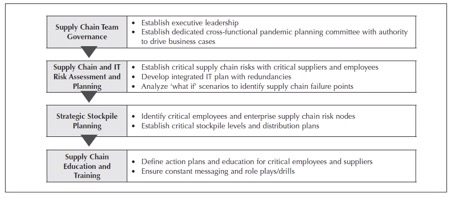Introduction to… Planning for the Inevitable: The Role of the Federal Supply Chain in Preparing for National Emergencies
This is another blog from my colleague Rajinder Bhandal. Keep them coming!
March 2023
Reflecting on the year 2010!
Back in 2010, Professor Rob Handfield produced a report titled ‘Planning for the Inevitable: The Role of the Federal Supply Chain in Preparing for National Emergencies’ on behalf of the IBM Center for The Business of Government. Do you remember reading this? More importantly, who took note of ‘the framework for assessing federal government preparedness (using pandemic planning as an illustrative example)’ and actually followed up with meaningful action???
Professor Handfield highlighted in the report that:
- “One of the most important observations regarding preparedness planning is that 85% of the assets required to respond to any emergency resides within the private sector.”
- “A ‘multi-pronged collaborative approach’ is fundamental to successful preparedness planning.”
Planning for the Inevitable
The report clearly outlines a prominent planning framework for federal government agencies and businesses to apply in emergency situations, towards supply chain preparedness. The federal supply chain preparedness planning framework calls attention to the four components: (i) supply chain team governance, (ii) supply chain and IT risk assessment and planning, (iii) strategic stockpile planning, (iv) supply chain education and training, with more detail provided in the Figure 1 below:

The report is based on data collected in the form of 50 interviews, with professionals in the private and public sector. Accordingly, the framework for assessing federal government preparedness (using pandemic planning as an illustrative example), offers a benchmark towards reviewing emergency planning on a level 5 to level 1 measure. For instance, level 5 attracts a high level of urgency with regards to action needed, whereas level 1 encompasses limited action.
“Houston, we have a problem”
In 2019, the COVID-19 pandemic highlighted the sheer extent and lack of preparedness across nations. Handfield was ahead of the curve in 2010 with a [28 page] report and detailed recommendations and reach out to federal agencies towards conceptualising the notion of ‘planning for the Inevitable’ to reduce supply chain fragility during national emergencies. With the wisdom of hindsight, we learn the value of such knowledge today… and perhaps can begin by actually creating interventions on the basis of such expertise and by simply being “all ears” in the here and now.
The main takeaway message in all of this is echoed nicely by the words of the great maestro Oscar Wilde… “It is what you read when you don’t have to that determines what you will be when you can’t help it.”
Key recommendations
With thanks and much appreciation to Professor Rob Handfield for writing the report and for taking the time to provide the following recommendations:
~ Recommendation One: Governance is a critical foundation for emergency planning.
~ Recommendation Two: Supply chain risk assessments should be carried out to map out key stakeholders and weak nodes within the responsibility of federal government agencies.
~Recommendation Three: Stockpile planning and allocation processes should be improved.
~Recommendation Four: Training of key individuals in conjunction with risk planning is an important component to planning.
It would be wonderful to track and report progress along the lines as mentioned above and document the types of interventions currently taking place.